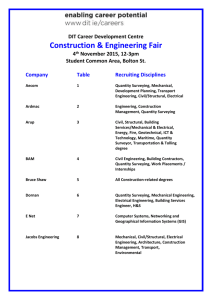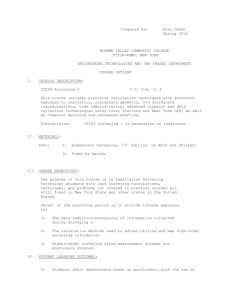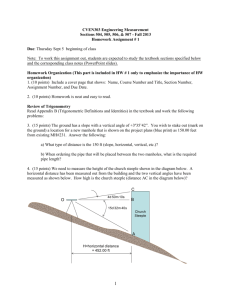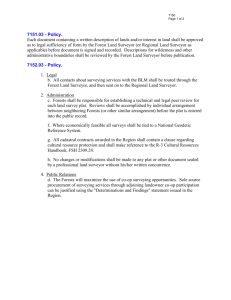to Student Surveying Day Activities
advertisement
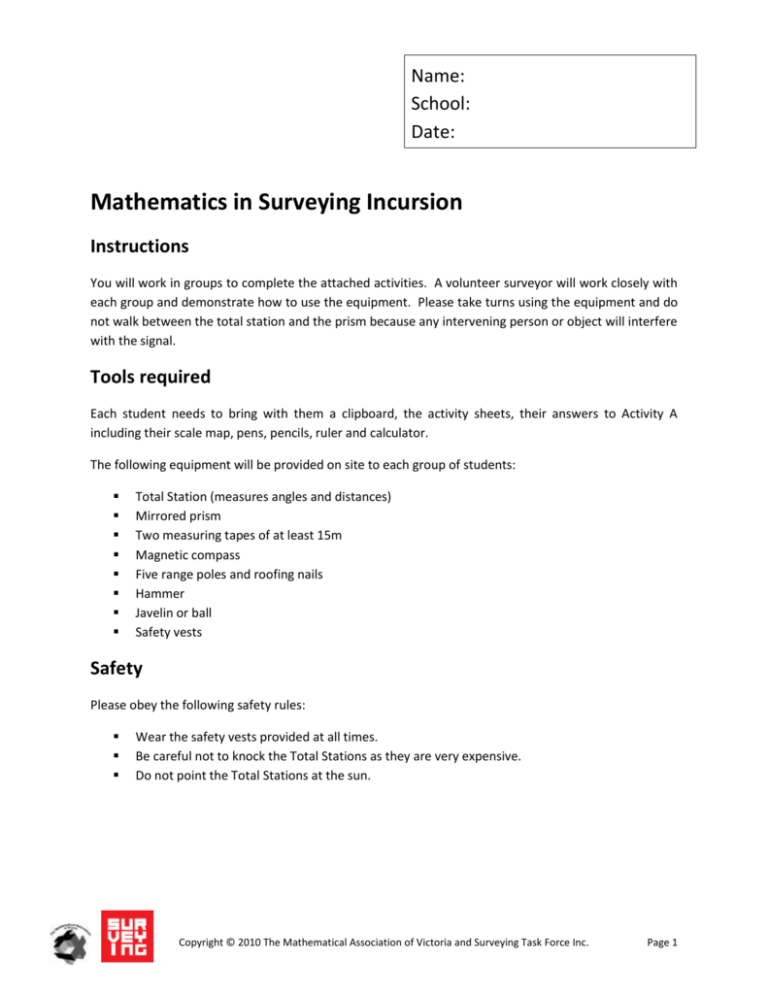
Name: School: Date: Mathematics in Surveying Incursion Instructions You will work in groups to complete the attached activities. A volunteer surveyor will work closely with each group and demonstrate how to use the equipment. Please take turns using the equipment and do not walk between the total station and the prism because any intervening person or object will interfere with the signal. Tools required Each student needs to bring with them a clipboard, the activity sheets, their answers to Activity A including their scale map, pens, pencils, ruler and calculator. The following equipment will be provided on site to each group of students: Total Station (measures angles and distances) Mirrored prism Two measuring tapes of at least 15m Magnetic compass Five range poles and roofing nails Hammer Javelin or ball Safety vests Safety Please obey the following safety rules: Wear the safety vests provided at all times. Be careful not to knock the Total Stations as they are very expensive. Do not point the Total Stations at the sun. Copyright © 2010 The Mathematical Association of Victoria and Surveying Task Force Inc. Page 1 Activity A: In class 1. Watch the Surveying video and fill in the gaps: Surveying is the science of ______________ and ______________ Engineering surveyors are involved in building, from bridges and ______________ to tunnels and ______________ A 2009 graduate salary is about $______________ A fully licensed surveyor can expect $______________ A degree in ______________ or ______________ takes about 4 to 5 years and will allow you to gain professional accreditation as a surveyor. 2. On graph paper draw a scale map of this square using a scale of 1cm:1m (ie 1:100). Mark North clearly on your map. Label the corners (vertices) N, E, S and W. 3. Calculate the side length of the square (shown above) using Pythagoras’ Theorem in exact form and rounded to 2 decimal places. 4. Point P is on a bearing of 175° from point N and 290° from point E. Mark this point P on the scale map using protractors. Remember bearings are measured clockwise from North. 5. Point P is also 13.4m from point S and 11.1m from point W. Mark point P on the scale map using a pair of compasses and check that it is the same point as found in question 3. 6. Using the Melways, measure the distance in metres from your school oval to a building specified by your teacher. Record your answer here as it will be used in Activity B: ____________ metres. 7. Convert these angles to degrees, minutes and seconds (DMS) without using a calculator. (a) 40.5o (b) 63.25o (c) 192.75o (d) 206.6667o Copyright © 2010 The Mathematical Association of Victoria and Surveying Task Force Inc. Page 2 8. Convert these angles to degrees, minutes and seconds (DMS) using a calculator. (a) 102.58o (b) 354.33o 9. Convert these angles to decimal without using a calculator. (a) 27o 30’ (b) 15o 20’ 10. Convert these angles to decimal using a calculator. (a) 87o 55’ 04” (b) 123o 06’ 15.55” 11. Calculate the average angle from the following angles: 7o 35’ 44” 7o 36’ 08” 7o 35’ 56” 12. Calculate the following: (a) 90o - 30o 25’ 10” (b) 90o - 46o 52’ 31” Activity B: Setting out a Square Duration: 45 minutes Scenario: You are working as a surveyor and are required to set out a series of points to allow a builder to construct the foundations of a square shaped building. You have already drawn a scale map of this shape in activity A. You will use surveying equipment to set out the corners of a full-size square on the lawn and then locate a sewage outlet. The equipment will help you pinpoint the positions by telling you which directions and distance to move. Step 1: Set up the total station at point 0, the centre of your square. Please ensure you have enough space around you so that your square will not interfere with the squares of other groups. Step 2: Use a magnetic compass to locate the direction of North. Turn (When we use the term move the total station it means to physically pickup the total station and move it) the Total Station so that it is facing north. Step 3: One student takes the prism and walks approximately 10m along this northern direction. The student using the Total Station needs to then guide the student with the prism left or right so that they are in line with north. Step 4: The student using the Total Station needs to guide the student with the prism backwards and forwards until they are 10m away (and still in line with north). Insert a nail in this spot and a range pole next to it. Step 5: Turn the Total Station 90° and repeat steps 3 and 4 to find the Eastern, Southern and Western corners of the square. Copyright © 2010 The Mathematical Association of Victoria and Surveying Task Force Inc. Page 3 Step 6: Now we will locate the position of the sewage outlet. The sewage outlet is on a bearing of 175° from point N and 290° from point E. Remember bearings are measured clockwise from magnetic North. Use the Total Station to find the bearing from point N and a magnetic compass to find the bearing from point E. Then use the tape measures to find where these bearings intersect and insert a range pole at this point. Step 7: Check the accuracy of this sewage outlet position by using the two measuring tapes to find the intersection of 13.44m from point S and 11.12m from point W. Questions 1. Measure the length of the sides of your square using the tape measure. Expected distance: _________m (to 2 decimal places) Actual distance of side length NE: _________m Actual distance of side length ES: _________m Actual distance of side length SW: _________m Actual distance of side length WN: _________m 2. Calculate the mean side length: _________m 3. Calculate the expected area of your square: _________m2 4. Use your answer from question 2 to calculate the actual area of your square: _________m2 5. Name some reasons why the actual distances and the actual area are different from expected. Copyright © 2010 The Mathematical Association of Victoria and Surveying Task Force Inc. Page 4 Activity C: Measuring how far a javelin has been thrown Duration: 20 minutes Task: Measure how far a javelin has been thrown using a similar method to that used at the Olympics. Total Stations are now used in the Olympics to calculate how far a javelin has been thrown. Previously measuring tapes were used, but they were slow and not accurate enough. A (javelin) b c θ ------------------------------------------------------------throw line---------C B a (launch point) (total station) Step 1: Make the throw line by laying out the measuring tape in a straight line. Mark on the throw line where the javelin (or ball) should be launched (point C). Set up the Total Station on the throw line (B) a safe distance from where the javelin (or ball) will be launched (at least 4 metres away). Step 2: Make sure the field is clear of people and equipment and throw the javelin (or ball). Where it lands is point A. Step 3: Record the following measurements below: Your estimate of how far the javelin (or ball) has been thrown: _________m Distance between the Total Station and the launch point: a = _________m Distance between the javelin and the Total Station: c = _________m Angle ABC: θ = _________ Step 4: Substitute these measurements into the following formula to calculate b, the distance thrown: b= a 2 c 2 2acCos b = _________m Step 5: Measure the actual distance thrown using a tape measure: _________m Further information can be found at www.m-a.org.uk/what_use/SportsMeasurement.doc downloaded on 12/7/2010. Copyright © 2010 The Mathematical Association of Victoria and Surveying Task Force Inc. Page 5 Activity D: Measuring the height of a building Duration: 20 minutes Task: Measure the height of a building using a Total Station, that is, find the height AD in the diagram below. In the diagram: A is the top right corner of the building B is the position of the Total Station lens that you will look through C is the point vertically below B on the ground D is the base of the building and is on ground level vertically below A E is vertically below point A on the same horizontal level as B Z is the point vertically above B (called the zenith point) 1. Before you make any measurements, test your estimation skill by estimating the height of the building. My estimate of the height of the building is _______metres 2. Measure the height of the Total Station lens (BC) _______metres (to 2 decimal places) 3. Record here your answer from Activity A, question 6. My measurement of the distance (CD) from the middle of the Oval to the building is_______metres Copyright © 2010 The Mathematical Association of Victoria and Surveying Task Force Inc. Page 6 4. Point the Total Station at the top right corner of the band measure the Zenith Angle (angle ABZ). Each person in the group should take their own measurement as the Total Station is subject to errors over large distances. Person 1: _______degrees _______minutes _______seconds Person 2: _______degrees _______minutes _______seconds Person 3: _______degrees _______minutes _______seconds Average: _______degrees _______minutes _______seconds (use this in future calculations) 5. Calculate the angle of elevation from point B to the top of the building (angle ABE) _______degrees _______minutes _______seconds 6. Calculate length AE using trigonometry assuming triangle ABE is a right-angled triangle _______metres (to nearest metre) 7. Calculate the height of the building (AD) _______metres 8. Name some reasons why your estimate of the height of the building may be different to the actual height. Copyright © 2010 The Mathematical Association of Victoria and Surveying Task Force Inc. Page 7 Activity E: Measuring the height of a light post Duration: 20 minutes Task: Find the height of a light post using similar triangles. Choose a light post that is level with where we are standing and reasonably close by. Instructions: One student crouches down, eyes fairly close to the ground, at some distance from the target light post. Another student stands so that they are in a straight line between the light post and the crouching student. The crouching student then tells them to move forwards or backwards, until the top of their head lines up with the top of the light post, as shown in the diagram below: 1. Use a tape measure to make the following measurements and record them below: Your estimate of how tall the light post is: _________m The horizontal distance from the crouching student’s eyes to the standing student (ED): _________m (to 2 d.p.) The horizontal distance along the ground from beneath the crouching student’s eyes to the base of the light post (EC): _________m (to 2 d.p.) The height of the standing student (DG): _________m (to 2 d.p.) The height above ground of the crouching students eyes (EF): _________m (to 2 d.p.) 2. Calculate distance GH: _________m 3. Name the two similar triangles in the diagram above __________ and __________ 4. Use similar triangles to find the height of the light post (AC): _________m 5. Confirm your answer using the Total Station (Vertical height is displayed on the Total Station under “Meas and Rec” page 2 of 4): _________m Copyright © 2010 The Mathematical Association of Victoria and Surveying Task Force Inc. Page 8 ----------------------------------------------------------------------------------------------Feedback Form Please take a few moments at the end of your Mathematics in Surveying Incursion to fill in this feedback form and hand it over to the Coordinator. Name (optional): School: Date: Please rate the tasks in terms of how interesting and useful you found them. Poor Below Average Average Good Excellent Surveying Video A: In class activity B: Setting out a square C: Javelin (or ball) D: Building height E: Light post height Surveyor support Any other comments and suggestions (both positive and negative): Copyright © 2010 The Mathematical Association of Victoria and Surveying Task Force Inc. Page 9 Activity F: Post Activity Questions: 1. Calculate the volume of soil to be removed if the square in Activity B is to be excavated 2m deep. Please provide your answer in cubic meters. 2. Calculate how many trucks will be required to remove the soil, if one truck can hold 26m3. 3. Calculate the distance x in the diagram below: 4. Supposing you recorded the following side lengths of the square set out in Activity B: NE: 14.14m ES: 14.08m SW: 14.08m WN: 14.14m Which corner has been placed too short and by how many centimetres? 5. Calculate distance b, (how far the javelin has been thrown), by substituting into b= a 2 c 2 2acCos Copyright © 2010 The Mathematical Association of Victoria and Surveying Task Force Inc. Page 10 6. Calculate the angle θ in the diagram below by rearranging b = a 2 c 2 2acCos 7. Calculate length AC in the diagram below: 8. Using similar triangles, calculate length AE in the diagram below: Note: diagram not to scale Copyright © 2010 The Mathematical Association of Victoria and Surveying Task Force Inc. Page 11 Activity G: Post Activity Extension Questions: 1. Suppose the sewer outlet was to be placed on a bearing of 160° from point N and a bearing of 300° from point E. Calculate the distance this sewer outlet is from points N and E using the Sine Rule. 2. Calculate the distance this sewer outlet is from points S and W using the Cosine Rule. Copyright © 2010 The Mathematical Association of Victoria and Surveying Task Force Inc. Page 12


![the registration form [DOC format, 30KB].](http://s3.studylib.net/store/data/007326701_2-7aa061ae2787fe2d09dcfa408150476a-300x300.png)
